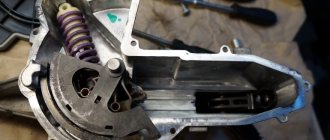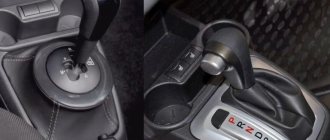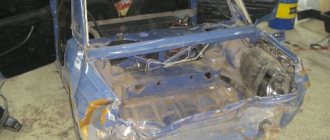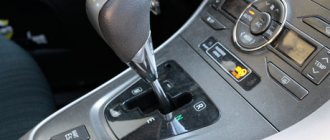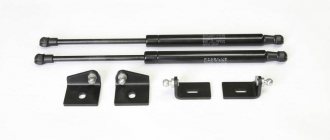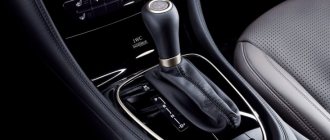New technologies in domestic production
Buyers choosing a new car look thoughtfully at the new AMT from Lada. What is it, what is its operating principle? In fact, this is a regular manual transmission, only it does not have a clutch pedal. Instead of three levers, you only get two - gas and brake. The compact gearbox has off, on and shift modes, which replace the familiar pedal.
Reviews of the Lada Vesta robot show that not everyone liked the manufacturer’s innovations. The automated gearbox is developed on the basis of the manual transmission of VAZ cars. The control system uses the latest ZF developments, which help to change gears faster. In terms of quality, the new AMT is clearly better than the old technologies on the Lada Kalina, but at the same time inferior to European analogues (BMW, Ford, etc.). What positions are there on the shift lever in the new Lada Vesta?
- Auto mode – allows you not to think about changing gears at all.
- Neutral position is acceptable when the car is parked.
- Reverse – in this position, as you might guess, the car will go backwards.
- Manual shift - allows you to change gears yourself if you want to overtake someone or save fuel. If you want to downshift, then you don’t have to touch the lever at all - the Lada itself will do everything for you if you take your foot off the gas pedal.
What changes are at VAZ
It's not perfect, but it's a good car. Yes, she has some flaws, the robot is creepy. The finishing is crooked in places, the navigation is unclear. We saved on little things that are inconvenient to live without. They installed heated glass, but it doesn’t really heat anything up. Such things exist, and they can be fixed during the update. The second important thing is that in the near future something will change at VAZ. What is happening there now are complex processes that are difficult and incorrect to discuss if you are not deep in the topic. VAZ is suffering colossal losses.
Comparison of Lada Vesta with Hyundai Solaris.
It’s not clear how to feel about Boo Andersen’s management. How will this whole story end? In fact, the car gets a strange theme, but the model is definitely successful. This is a step forward for the plant. But, given the current economic circumstances, Vesta, under certain circumstances, may become the stone that will drag the Volzhsky plant to the bottom.
What is the difference between AMT and automatic transmission?
How does the robot on the Vesta work and how does it differ from a car with an automatic transmission? In terms of structure, it is designed exactly the same as a manual transmission. A robotic one has little in common with an automatic transmission. If in a conventional automatic transmission the torque is transmitted from the engine to the wheels by a torque converter, then in a robotic gearbox the torque is transmitted through gears. The robot was made on the basis of a VAZ mechanical transmission. The AMT consists of the mechanical box itself, the clutch and the electronic unit that controls it.
When developing the new box, engineers from the Tolyatti plant used the experience of foreign manufacturers. And the clutch included in the AMT package is made in France. The part is protected by a wear compensation function that prevents premature failure. There have not yet been any cases of warranty claim registered.
Many people are perplexed: why can’t an automatic transmission be developed on a Russian basis, because so far no domestic car has such an improvement. The answer is simple: the development of automatic transmissions is possible already on the existing base, which does not yet exist in Russia. And production based on foreign developments will significantly increase the final cost of the car. For comparison, using an automatic machine will cost approximately twice as much as a robot.
Vehicle inspection
It all starts in the little things. We approach the car from behind and try to open the trunk. At first it doesn’t work because there is no open button. What you need to do to do this is press the button on the key fob. After a few seconds everything worked. Let's go further and look into the trunk, it's quite decent. There are hinges, which are also found on all budget sedans. Secondly, the upholstery is made of something unknown. There is plenty of legroom in the rear seats and the car is spacious.
As for the Lada Vesta engine. If it had not had a VAZ engine, the car could have been much more expensive. It's the same story with the gearbox. There are manual transmissions; they don’t make automatic transmissions in Russia. Therefore, we decided to take a classic VAZ gearbox and attach attached electronics to it, control systems that can be purchased, and get our own gearbox. And so they did. The node that stands is called the AMT robot. In essence, it is a five-speed VAZ manual with additional equipment. That's why the car only has two pedals.
Instructions for using a machine with AMT
How to use the new gearbox? Reviews from owners of the Lada Vesta 1.8 robot indicate that you still need to learn how to use the AMT. The car's on-board computer displays information that helps monitor the operation of the transmission:
- Mode (manual/automatic).
- Active transmission.
- Brake pedal activity.
So how do you start a Lada Vesta with AMT? To do this you need to follow a number of simple steps:
- Press the brake pedal.
- Move the shift lever to the neutral position.
- Start the car.
It is important to note that any changes in the position of the selector can only be made while the brake pedal is pressed. If you want to park the car, the manufacturer recommends turning off the engine, leaving the handle in the manual or automatic mode position. Very often, novice drivers have a question: what to do if you get stuck in a traffic jam on a slope? To prevent the car from rolling back, it is permissible to lightly press the gas pedal. When driving on a slope, the robot selects first or second gear so that the engine does not stall.
Another useful feature of LADA with AMT is that it can be started from a pusher. Rope launch is activated at speeds of 7 km/h and above. The car also has a transmission brake function. When rolling down an inclined surface, it is permissible to use the brake pedal for more effective braking. All these useful modes make operating the Lada Vesta with AMT convenient and comfortable.
Test drive by specialists
What do professionals say about the robot box in Lada Vesta? You can find many reviews of the new product on the Internet. Most note the slow response of the box during acceleration. Some call the driving style of the Lada Vesta robot a style for summer residents. Slow acceleration of the car contributes not only to fuel economy, but also to passive safety. No matter how hard you try to squeeze out maximum speed in order to overtake three or two cars, it is unlikely that you will be able to do it quickly. True, the car behaves a little more cheerfully in manual mode, in which it is more realistic to squeeze the maximum out of the 1.8-liter engine. But, if you get used to this driving style, you begin to notice the advantages: the parts are made well and do not fail for a long time. Compared to manual and automatic transmissions, AMT provides significant fuel savings.
After the driver presses on the gas and the engine picks up speed, the transmission begins to upshift. The problem is that the robot on the Vesta cannot do this without reducing the thrust. The switching time fluctuates around 2 seconds, which can be quite annoying at first. But you won’t feel any jerks, the clutch is as smooth and comfortable as possible. In the reviews of the owners of the Lada Vesta robot in 2022, you can find a comic name for this driving style - driving a Chinese dummy. Due to the excessively sharp speed difference between first and second gear, Vesta drivers and passengers nod due to uneven acceleration.
But, despite various points of view, most reviews about the Vesta 1.8 robot indicate that the introduction of an automated manual transmission was a big leap forward for the domestic manufacturer. Car enthusiasts hope that the improvements will not end there; Lada engineers will properly finalize the box, and it will be a pleasure to drive. By the way, on the official website of the automaker there is already a survey on what users would like to change in the AMT box. So you should be patient - improvements are just around the corner.
Appearance
In general, the Lada Vesta is a decent car, but there are some problems. If the weather had been sunny now, we would not have seen anything on the instruments. Everything is glare, the numbers are not visible, there is no brightness adjustment. There is a trip computer, which is quite decent. Its numbers are visible in any light. Then things start to get weird again. The windshield is heated - you can see the threads that are built into it and should warm the glass.
Front and rear heating is turned on with one button. But for some reason the front one takes a long time to warm up, it’s easier to clean the glass yourself. There is no heated steering wheel, although we have a cold climate. But the heated seats provide good warmth. If you compare it with Mazda, it has heating with three positions, everything is done in a complex, modern way. You turn it on and wait a long time before it starts to heat up. After half a minute it becomes warm, and after two minutes you already want to turn it off.
Robot on Vesta: reviews
Drivers online are furiously discussing Lada's innovation. Both experienced drivers and beginners who have previously driven only a manual transmission become participants in the debate. Reviews from owners of a Lada Vesta with a robot indicate that not everyone has an unambiguous perception of this new product. On the one hand, there are no those who are 100% satisfied with the AMT of the domestic manufacturer. On the other hand, is it worth being so critical of the first attempts to automate machine control?
Let's take a closer look. The main thing when buying a Lada Vesta with AMT is to clearly understand who such a car is intended for. First of all, this is a car for a quiet and comfortable ride around the city, and not for racing. Vesta with a robotic gearbox is ideal for city traffic jams. If you are tired of manual gear shifting, but foreign cars with an automatic transmission are not yet available to you, then the new Lada will be an excellent option.
Reviews about the Lada Vesta 1.8 robot show that automatic transmission lovers should not buy a car with AMT. Still, these are two completely different boxes that have little in common with each other. Fast automated transmissions of such giants as BMW or Porsche cannot be compared with the Lada gearbox. They change gears quickly and smoothly, without delay. The robot on the Lada Vesta is more like the AMT of old Japanese cars. Nevertheless, this is an excellent compromise option for those who are tired of riding with mechanics.
About the robot AMT 2.0 Lada Vesta
Background:
- I bought a Lada Vesta SV Cross
- Lights and lighting in the interior of Lada Vesta SV Cross
- Comparison of Vesta SV Cross with UAZ Patriot
- Standard ERA Glonass
- Inspection of the bottom of Lada Vesta 2020
- Review of the LADA Vesta SV Cross interior. Seats and dimensions.
- Lada Vesta trunk review
Hello everyone, Dmitry Flegantov and my LADA Vesta SV Cross are with you!
Let's talk about the transmission, namely the AMT 2.0 robotic transmission, which is equipped in my LADA Vesta SV Cross car with accessories from Autodream.
There are many different rumors floating around the Internet about the first generation robot, most of them are true, but most are not. In any case, the robot has currently been updated to version 2.0, which will be discussed in this article.
But first, a little materiel. There are three main types of automatic transmissions:
Classic automatic transmission with torque converter.
Variator (V-belt transmission).
Robot.
The first option , automatic (automatic transmission), is the most “ancient”, reliable, but not without its shortcomings. An automatic transmission consists of a torque converter, planetary gearboxes and clutches, an automation unit with a hydraulic unit, which control the whole thing. The advantages of a classic automatic are smooth, almost imperceptible switching, and, naturally, comfort in motion. And then there are the cons. The automatic transmission itself is expensive, expensive to repair, requires frequent oil changes, and the oil must be of particularly high quality, i.e. again expensive, the automatic does not like overloads (slipping in the snow, for example). And also, with an automatic transmission, fuel consumption increases by about a liter compared to a manual transmission.
The second option , a variator, has a slightly different design. Modern CVTs combine a torque converter, a planetary gear with a clutch, as it looks like on a “classic”, but the main working unit here is a mechanism consisting of two pulleys that can converge and diverge under the action of hydraulics, and a metal belt located between them that moves along the pulleys and thereby smoothly changes the gear ratio. This transmission also has an electronic control unit and a hydraulic unit. The advantages of the variator are the absolutely stepless change in gear ratio; the car accelerates smoothly, like a trolleybus. Sometimes, to make this box work more familiar to the driver, virtual gears are created programmatically and light steps appear when “switching” (for example, this is how the variator works on the new Renault Arcana). The advantage of a variator compared to an automatic transmission is a smoother transmission of torque from the engine, without a power break (which occurs with an automatic transmission when switching), this allows you to save some fuel and get greater driving comfort. The main disadvantage of the variator is that the belt is “engaged” with the pulleys through frictional force... Naturally, this causes wear on the belt and wear on the pulleys. Wear greatly accelerates during dynamic driving and when driving off-road (which is extremely contraindicated for a CVT). Any slipping of the belt on the pulleys causes an unscheduled reduction in the life of the unit. Repairing a CVT is complicated, expensive (like the unit itself), and has a shorter service life than an automatic transmission. The driving style with a CVT is to slowly move around the city, without sudden starts and decelerations, without overloading the car, then the CVT will live for a long time. Also, the variator is capricious regarding the quality of the oil, which is replaced quite often.
The third option is a robot, which is installed in our LADA Vesta SV Cross. This type of automatic transmission is the youngest, its development was due to the advent of cheap, reliable and compact microelectronics, and the development of digital computers. The robot is a regular manual gearbox, but instead of the driver, the clutch and gear shift lever are controlled by electric actuators (actuators) according to given algorithms. You may ask, why is this transmission called a robot? And because the switching algorithms are not rigid, but adaptive, the control unit analyzes many parameters and selects the switch map that will be most effective for the driving style specified by the driver. At the same time, the electronics tries to make switches in the most gentle mode, so as not to cause discomfort for the driver and passengers or damage to transmission components. The advantages of the robot, relative to the above types of automatic transmissions, are the low cost of the unit, reduced (even in comparison with manual transmission) fuel consumption, cheap and simple repairs, the oil in the box is designed for the entire service life of the car. With this “box” you can slip, load the car, and, if necessary, “rock” the car in order to get out, for example, from mud. The disadvantages of the robot are: the electronic control unit can hypothetically fail and the box will go into emergency mode. When shifting a robot with one clutch (as in our case), power gaps are felt, which are slightly larger than with an automatic transmission.
So, I’ve laid out the hardware, let’s return to our robot.
The first generation of the VAZ AMT with a 1.6 engine alienated users. The robot was not optimized, tuned, “kicked”, “stupid”, burned the clutch. Naturally, this could not continue for long, and in 2022 the plant released an updated version, called AMT 2.0. And also, this transmission began to be combined with the new VAZ 1.8 engine (122 hp). The updates affected primarily the software, which was installed in the new control unit (which is why it is impossible to reflash older versions of the AMT). The clutch disc acquired a new composite composition, and there were minor changes in the box itself. Naturally, I became extremely curious to try out all these changes and it was on this version with the 1.8 engine that I took a test drive...
What can I say, I was surprised. The robot was absolutely reminiscent of an automatic transmission in terms of its operating algorithm. Yes, the gaps were felt, but they were very soft, quick and did not cause nods (let alone kicks). No matter how much I pressed the gas pedal, the robot did what I would have done with a manual car! Bravo AvtoVAZ, great job!!! I was pleased with the “creeping mode” when the brake pedal is released, which is also activated when moving backwards. There were no twitches or problems that scare people online!!!
The decision was taken. I buy Vesta SV Cross only 1.8 and only on robot!
Having already operated my car with this transmission and having driven 13,000 km, I can sum up some results. So, no twitching appeared either in crawling or in other driving modes, shifting comfort was also not lost, the car copes well off-road, the clutch never overheated and the gearbox did not malfunction, the smell of a scorched clutch (as opposed to the smell of scorched tires)) have never been. There is protection “from the fool” and it’s very pleasing! Almost all options are provided that protect (from rash actions of the driver) the box and the car, as well as surrounding objects from damage. When overtaking, when you need to do it as dynamically as possible, the robot quickly, without any hesitation, shifts the gear down and you accelerate dynamically. We simply keep the gas pedal pressed in all modes; it does not need to “play”, as was recommended to do on older versions of the firmware.
In this video I show how the robot behaves in different conditions:
And here’s what Vesta SV Cross is capable of with a robot off-road:
I hope this was helpful! See you again!
To be continued…
- Engine speed of Lada Vesta at different speeds
Author's column by Dmitry Flegantov
The nuances of driving the Vesta robot
As with all cars, when driving a Lada robot, there are some nuances that should be taken into account when purchasing. They can be understood most clearly if you read the reviews about the robot on Vesta. For example, the gearbox is sometimes tricky when changing gears. If you are driving in second gear, slowly picking up speed, the robot may misunderstand you and shift to first gear instead of third. This often happens during not very dynamic acceleration.
If you need a faster start, there is a little trick. Usually, when driving on the highway, the robot engages fifth gear. If you press the gas pedal to the floor, the car engages third gear, after which the speed immediately increases. This allows you to overtake on high-speed sections of the road. After completing the maneuver, just release the pedal to its normal state, and the AMT will switch back to 5th gear.
As we have already said, a processor is inserted into the robot on the Lada, which reads the behavior and driving style of the driver and adapts to it. If you want the most dynamic acceleration without jerking, then you can try the following driving style:
- Accelerate without releasing the gas pedal. The robot itself will select the right moment to shift from first gear to second, and then to third. But be prepared for a slight jerk between shifts.
- Once your car reaches a speed of 40 km/h, release the gas pedal slightly. At this moment, the car will smoothly shift gears.
- The same action must be repeated at a speed of about 60-80 if you are going to go even faster.
- If at speed 4 you do not press the gas pedal to the floor, then, most likely, AMT will immediately set speed 5, at which dynamic acceleration is impossible.
- When driving uphill, the robot itself slows down if it becomes difficult for the engine to hold the current gear. For beginners, this nuance is especially good: now your car will definitely not stall while climbing a slope.
You still need to get used to driving a manual automatic transmission, but the convenience and reasonable cost of the AMT completely hides all its shortcomings.
Reviews of the Lada Vesta robot gearbox
We have collected real reviews from people and present them to your attention:
Overall the gearbox is not bad. Sometimes the robot twitches, maybe it’s not used to it yet. Mileage 7800 km.
I didn't like the gearbox. I borrowed it from a friend, drove it for a week, but it didn’t work. I bought myself a mechanic and I don’t know what the problem is, I’m happy with it.
A good box if you don't constantly sink it into the floor. I finally got used to my driving style after 3000 km. If you are a Schumacher, then this is not for you.
Generally speaking, the box is a robot for everyone. It all depends on your driving style. In some moments it is inferior to torque converters, due to their reliability and simpler design, but with proper maintenance and operation it will not leave you indifferent. The choice is yours. We wish you good luck in purchasing a car.
Quite recently, a new product on the domestic market went on sale - the Lada Vesta with an automated manual transmission. Reviews from owners about the robot on Vesta vary greatly: some swear and say that they will never drive such a car again, while others, on the contrary, are happy with the purchase. In this article we will figure out what AMT is on a Lada and whether it is worth buying a car with an unusual configuration.
What configuration does the AMT come with?
Lada Vesta with an automated manual transmission is available only in luxury configuration. When purchasing this assembly, you can also purchase a manual transmission, which is standard. But for the robot you will have to pay about 25,000 rubles.
Considering that the price for a Lada Vesta in the maximum configuration exceeds 600 thousand, a reasonable question arises: is the game worth the candle? What advantages and disadvantages can be found in such a supplement?
Advantages and disadvantages of the robot on Vesta
Let's start with the advantages. According to reviews of the robot on Vesta, the machine has the following undeniable advantages:
- Equipped with the “Slope Start Assistant” program – even if you park or get stuck in a traffic jam on a slope, this option will help you avoid rolling back when starting. The gearbox increases speed at the start, the clutch becomes stiffer.
- Increased clutch life - thanks to the soft and smooth operation of the AMT, the service life of the part will be long even with careless driving. The shift box is protected against accidental pressing of the lever: if you start shifting it chaotically, the car simply will not react.
- AMT is adaptive and has 26 behavior patterns that it selects depending on the driver’s behavior. How it works? The program reads how the driver operates the gas pedal and, depending on this, switches the clutch at the right moment.
- Fuel economy is hard to believe, but the robot on the Lada is really more economical than a manual or automatic transmission. Thanks to smooth switching, you can use several times less gasoline.
- AMT consumes less oil than manual transmission - also a significant factor in favor of choosing a new configuration.
Reviews of the robot box on Vesta also show the disadvantages of an automated manual box:
- The absence of a parking mode makes parking more difficult; when parking, it is better to leave the control lever in manual or automatic mode to avoid rolling back.
- Gear changes are jerky - between 1st and 2nd gears there is a decrease in speed, which can noticeably slow down the car.
- Slow acceleration - a car with AMT takes a few seconds longer to pick up speed than a car with a manual transmission.
- The inconvenience of the manual mode is that the gearbox is not designed very well, and this makes manual driving of the car less convenient.
Which is better to choose manual or AMT?
The choice between a manual transmission and AMT should be made with a cool head, having calculated all the pros and cons in advance. On the Internet you can find many good reviews about the mechanics or robot of the Lada Vesta. But most drivers opt for an automated manual transmission. It is much more convenient and economical to use. But lovers of classics and conservatives still prefer the usual mechanics. You can only understand whether a car with AMT is suitable for you or not by trying it in action.
Principle of operation
The uninitiated reader will be interested in the operating principle of this unit. At its core, the Lada Vesta variator, which will eventually be installed on the “Lux” model, is an advantageous combination of a manual transmission and an automatic transmission with the ability to both automatically change speeds and manually by manipulating a lever located in the cabin.
And yet, how does this inherently ingenious device work? The five-speed Euro gearbox from Renault is equipped with a hydraulic drive - quite leisurely, but reliable in operation and practically trouble-free. This drive acts on the engine, adjusting its speed and fuel injection intensity in accordance with the factory settings, corresponding to the required power for each specific gear (more details in the attached photos).
With manual control, the unit transmits the movement of the lever to the functioning mechanism (moving forward - upshifting, moving the lever back - downshifting), as when using a manual transmission. In the automatic version, gears are switched without driver participation - special sensors record engine speed and provoke an increase (decrease) in the gear number when it reaches a certain torque.
